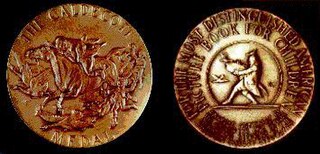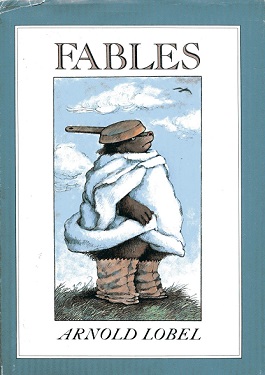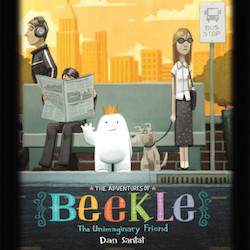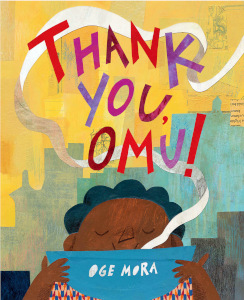
The Randolph Caldecott Medal, frequently shortened to just the Caldecott, annually recognizes the preceding year's "most distinguished American picture book for children". It is awarded to the illustrator by the Association for Library Service to Children (ALSC), a division of the American Library Association (ALA). The Caldecott and Newbery Medals are considered the most prestigious American children's book awards. Besides the Caldecott Medal, the committee awards a variable number of citations to runners-up they deem worthy, called the Caldecott Honor or Caldecott Honor Books.

Randolph Caldecott was a British artist and illustrator, born in Chester. The Caldecott Medal was named in his honour. He exercised his art chiefly in book illustrations. His abilities as an artist were promptly and generously recognised by the Royal Academy. Caldecott greatly influenced illustration of children's books during the nineteenth century. Two books illustrated by him, priced at a shilling each, were published every Christmas for eight years.
James Edward Marshall was an American illustrator and writer of children's books, probably best known for the George and Martha series of picture books (1972–1988). He illustrated books exclusively as James Marshall; when he created both text and illustrations he sometimes wrote as Edward Marshall. In 2007, the U.S. professional librarians posthumously awarded him the Children's Literature Legacy Award for "substantial and lasting contribution" to American children's literature.

Chris Raschka is an American illustrator, writer, and violist. He contributed to children's literature as a children's illustrator.
David Small is an American writer and illustrator who is best known for children's picture books. His books have been awarded a Caldecott Medal and two Caldecott Honors, among other recognition.

Brian Selznick is an American illustrator and author best known as the writer of The Invention of Hugo Cabret (2007), Wonderstruck (2011), The Marvels (2015) and Kaleidoscope (2021). He won the 2008 Caldecott Medal for U.S. picture book illustration recognizing The Invention of Hugo Cabret. He is also known for illustrating children's books such as the covers of Scholastic's 20th-anniversary editions of the Harry Potter series.

Fables is a children's picture book written and illustrated by American author Arnold Lobel. Released by Harper & Row in 1980, it was the recipient of the Caldecott Medal for illustration in 1981.

Brian Lies is American author and illustrator of children's books. His works include his 2019 Caldecott Honor-winning picture book The Rough Patch and his NY Times bestselling bat series, which includes Bats at the Beach, Bats at the Library,Bats at the Ballgame, and Bats in the Band.

The Lion & the Mouse is a 2009 nearly wordless picture book illustrated by Jerry Pinkney. This book, published by Little, Brown and Company, tells Aesop's fable of The Lion and the Mouse. In the story, a mouse's life is a spared by a lion. Later, after the lion is trapped, the mouse is able to set the lion free. Adapting the fable, with the moral that the weak can help the strong, as a wordless picture book was seen as a successful way of overcoming the brief plot generally found in the source stories. While it was Pinkney's first wordless picture book, it was not the first time he had told the story, having previously included it in his Aesop's Fables, published in 2000. Pinkney, who had received five Caldecott Honors, became the first African American to win the Caldecott Medal for his illustrations in this book. His illustrations were generally praised for their realism and sense of place. The cover illustrations, featuring the title characters but no text, drew particular praise.

In the children's picture book Chanticleer and the Fox, Barbara Cooney adapted and illustrated the story of Chanticleer and the Fox as told in The Nun's Priest's Tale in Chaucer's Canterbury Tales, translated by Robert Mayer Lumiansky. Published by Crowell in 1958, it was the recipient of the Caldecott Medal for illustration in 1959. It was also one of the Horn Book "best books of the year".

A Ball for Daisy is a 2011 children's wordless picture book written and illustrated by Chris Raschka. The book tells the story of a dog named Daisy, who has a beloved ball destroyed and then replaced. Raschka won the 2012 Caldecott Medal for his illustrations in the book. The creation of the book took years but was praised for its ability to evoke emotion in the reader. A sequel, Daisy Gets Lost, was released in 2013.

Locomotive is a 2013 children's book written and illustrated by Brian Floca. A non-fiction book written primarily in free verse, the book follows a family as they ride a transcontinental steam engine train in summer of 1869. The book details the workers, passengers, landscape, and effects of building and operating the first transcontinental railroad. The book also contains prose about the earlier and later history of locomotives. The book took Floca four years to create, which included a change in perspective from following the crew of the train to following a family. Floca conducted extensive research including his own train ride and consultation with experts to ensure he had the details all correct.

This One Summer is a graphic novel written by Mariko Tamaki and illustrated by Jillian Tamaki published by First Second Books in 2014. It is a coming of age story about two teenage friends, Rose and Windy, during a summer in Awago, a small beach town. Rose and Windy discover themselves and their sexuality while battling family dynamics and mental disabilities.

The Adventures of Beekle: The Unimaginary Friend is a 2014 picture book by Dan Santat. The book won the 2015 Caldecott Award and tells the story of an imaginary friend in search of a child. This is the third book Santat has written, following The Guild of Geniuses (2004) and Sidekicks (2011), and his second picture book.

Radiant Child: The Story of Young Artist Jean-Michel Basquiat is a 2016 picture book biography by Javaka Steptoe about Jean-Michel Basquiat. Using a style similar to Basquiat's, the book tells the story of his childhood and early career. It won the 2017 Caldecott Medal and Coretta Scott King Illustrator Award for its illustrations.

Thank You, Omu! is a 2018 picture book written and illustrated by Oge Mora. The story is about Omu, who cooks a stew and shares it with her neighbors; they show their gratitude by bringing her food. The book started as an assignment for a class of Mora's at the Rhode Island School of Design, where it was seen by an editor from Little, Brown. Thank You, Omu was well reviewed and a recipient of the 2019 Caldecott Honor for its illustrations. The book's mixed media drew praise for their detailed depictions of characters and locations.

A Big Mooncake for Little Star is a 2018 picture book written and illustrated by Grace Lin. The story is about Little Star gradually eating the mooncake that her mother has baked. The book was a departure for Lin both thematically and in her use of illustrative style. The book was well reviewed and was awarded a Caldecott Honor in 2019. The illustrations feature heavy use of black and rely on both the pictures and words to convey the story and its themes.

Alma and How She Got Her Name is a 2018 children's picture book by Juana Martinez-Neal. Alma, whose full name is Alma Sofia Esperanza José Pura Candela, thinks she has too many names and so she asks her dad about them. He explains the various people she was named to honor. The book was spurred by Martinez-Neal's Peruvian immigrant experience and the birth of her children. The book was well reviewed and received a 2019 Caldecott Honor for its illustrations. The graphite and colored pencil illustrations feature only a few colors, including blue and pink. Martinez-Neal hoped to evoke the feel of a photo album, in keeping with the book's theme of family.

Bear Came Along is a 2019 picture book by Richard T. Morris and illustrated by LeUyen Pham. It tells the story of a group of animals on a river adventure. Published on June 1, 2019, Bear Came Along was based on memories Morris had of going to overnight camp for the first time. The watercolors, ink, and gouache illustrations Pham created were special for her. Critics wrote about her ability to juggle several different tones through the pictures. These illustrations were also generally seen as complementing the book's theme of being connected to others. The book was generally well reviewed and received a 2020 Caldecott Honor.

Doug Salati is an American author and illustrator of children's picture books. Doug Salati is the creator of the picture book Hot Dog, a New York Times bestseller and recipient of the 2023 Randolph Caldecott Medal and Ezra Jack Keats Award.


















